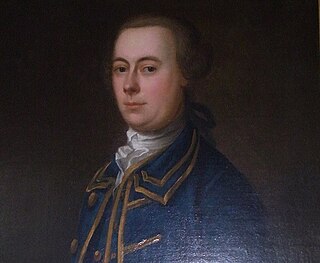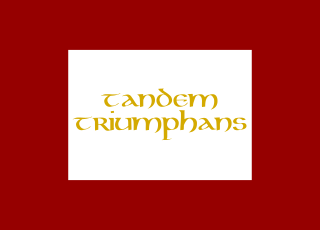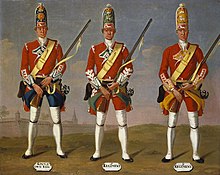
The Battle of Culloden took place on 16 April 1746, near Inverness in the Scottish Highlands. A Jacobite army under Charles Edward Stuart was decisively defeated by a British government force under Duke of Cumberland, ending the Jacobite rising of 1745.

Prince William Augustus, Duke of Cumberland was the third and youngest son of King George II of Great Britain and Ireland and his wife, Caroline of Ansbach. He was Duke of Cumberland from 1726. He is best remembered for his role in putting down the Jacobite Rising at the Battle of Culloden in 1746, which made him immensely popular throughout parts of Britain. He is often referred to by the nickname given to him by his Tory opponents: 'Butcher' Cumberland.

The Battle of Prestonpans, also known as the Battle of Gladsmuir, was fought on 21 September 1745, near Prestonpans, in East Lothian, the first significant engagement of the Jacobite rising of 1745.

The Highland charge was a battlefield shock tactic used by the clans of the Scottish Highlands which incorporated the use of firearms.

The Battle of Falkirk Muir, or Battle of Falkirk, took place near Falkirk, Scotland, on 17 January 1746 during the Jacobite rising of 1745. A narrow Jacobite victory, it had little impact on the campaign.

Lord George Murray, sixth son of John Murray, 1st Duke of Atholl, was a Scottish nobleman and soldier who took part in the Jacobite rebellions of 1715 and 1719 and played a senior role in that of 1745.

Sir Harry Munro, 7th Baronet was 25th Baron and the 28th chief of the Clan Munro. He was a Scottish soldier and politician. He was loyal to the Hanoverian dynasty and served as a captain in Loudon's Highlanders Regiment 1745–48.

William Drummond, 4th Viscount Strathallan, was a Scottish peer and Jacobite, who died at the Battle of Culloden.
Loudon's Highlanders, or the 64th Highlanders, or Earl of Loudon's Regiment of Foot, was an infantry regiment of the British Army.

Chasing the Deer is a 1994 British war film directed by Graham Holloway and starring Brian Blessed, Lewis Rae, Iain Cuthbertson, Fish and Mathew Zajac. It depicts the 1745 Jacobite Rebellion, in which Bonnie Prince Charlie landed in Scotland, trying to claim the British throne.

The Jacobite rising of 1745 was an attempt by Charles Edward Stuart to regain the British throne for his father, James Francis Edward Stuart. It took place during the War of the Austrian Succession, when the bulk of the British Army was fighting in mainland Europe, and proved to be the last in a series of revolts that began in March 1689, with major outbreaks in 1715 and 1719.

The Manchester Regiment was a Jacobite unit raised during the 1745 Rebellion and the only significant number of English recruits willing to fight for Charles Edward Stuart in his attempt to regain the British throne for his father. Raised in late November 1745, the majority were captured in December at Carlisle; eleven officers and sixteen members of the rank and file were executed in 1746, over a quarter of all those executed for their role in the Rising.
Lord Robert Kerr was a Scottish nobleman of the Clan Kerr and the second son of William Kerr, 3rd Marquess of Lothian. His family's surname at the time he lived was often also spelt as 'Ker'.

Sir John William O'Sullivan was an Irish professional soldier, who spent most of his career in the service of France, but is best known for his involvement in the Jacobite rising of 1745, an attempt to regain the British throne for the exiled House of Stuart. During the Rising, he acted as adjutant general and quartermaster general of the Jacobite army and had a major influence on the campaign.

David Morier, was an Anglo-Swiss painter of portraits, military subjects and historical scenes around and after the time of the War of the Austrian Succession and the related Jacobite rising of 1745.

The siege of Stirling Castle took place from 8 January to 1 February 1746, during the 1745 Rising, when a Jacobite force besieged Stirling Castle, held by a government garrison under William Blakeney.

Alexander Macdonald, 17th of Keppoch was a Scottish Jacobite and clan chief who took part in both the 1715 and 1745 Jacobite risings. He was killed at the Battle of Culloden leading a regiment composed largely of members of his clan, the MacDonalds of Keppoch.

The Seven Men of Moidart, in Jacobite folklore, were seven followers of Charles Edward Stuart who accompanied him at the start of his 1745 attempt to reclaim the thrones of Great Britain and Ireland for the House of Stuart. The group included English, Scots and Irish subjects of varying backgrounds linked mostly by their involvement in pro-Stuart intrigues. Although some had military experience, most of the men were relatively elderly by the standards of the time; some were already infirm and little suited to the rigours of campaigning.

The Jacobite Army, sometimes referred to as the Highland Army, was the military force assembled by Charles Edward Stuart and his Jacobite supporters during the 1745 Rising that attempted to restore the House of Stuart to the British throne.
The Battle of Culloden took place on 16 April 1746 at Culloden, Highland, near Inverness in the Scottish Highlands. A Jacobite army under Charles Edward Stuart was decisively defeated by a British government force under Duke of Cumberland, ending the Jacobite rising of 1745.















